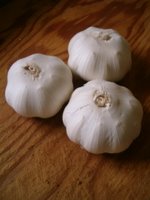




A clove of motherly love
When I was just a little tyke and feeling under the weather, my mother would make toast for me and rub a clove of garlic into both sides of the bread. I’ve associated the taste of garlic with the healing warmth of motherly love ever since.
I’m not ashamed to admit it—I love garlic! I eat it almost every day and use it in almost every dish I cook. Sara missed out on the richness of ethnic cooking when she was young, but I’ve more than made up for it by treating her to my style of cooking. Her favorites are tofu stroganoff (with mushrooms, onions, sour cream and garlic), Hungarian stir fried vegetables with garlic and paprika, and baked tomatoes stuffed with a garlic, mayonnaise and dill sauce, invented by yours truly.
If you haven’t guessed by now, Sara is vegetarian. So is our daughter, June. For our son Jim and I, I sometimes make pork stroganoff, stir fried chicken and vegetables, and baked tomatoes stuffed with diced ham, mayonnaise, dill, and—what else—garlic!
I like to grow my own garlic, because frankly the store-bought variety isn’t always fresh or tasty. To plant garlic in Canada, you should do it in the fall. You crack open the garlic head into cloves and plant them vertically in the soil, the same time that you do your spring bulbs.
Autumn planted garlic will remain dormant for a few weeks before it develops roots and a shoot. While winter sets in, the growth below ground slows down until the weather warms up in the spring. This gives the plant a chance to develop side buds that will grow and swell into the cloves.
If the garlic sprouts emerge from the ground before the spring thaw (as they inadvertently do here in British Columbia) they will be resistant to frost and snow, provided you mulch heavily.
I usually mix Advanced Nutrients Iguana Juice Grow into the soil at garlic planting time, then fertilize again in the spring. When the seedlings are standing proud and strong, I usually spray my entire vegetable garden with Scorpion Juice to inoculate against pathogens.
Garlic needs to be in a soil with a pH of 6.5 to 7.0, that has good drainage. Garlic is also susceptible to root diseases, so I treat the soil with Piranha and Tarantula, to colonize it with beneficial fungi and bacteria respectively. This wards off bad fungal, viral and bacterial diseases, and it also helps in the absorption of macro and micro nutrients.
Once spring growth has set in, every two weeks I give my garlic bed a side-dressing of a 100% organic nutrient (such as Iguana Juice or Mother Earth Super Tea Grow) and strong, healthy foilage develops. The robust foilage above ground means that large, healthy cloves are growing underneath.
My next posting will focus on Sara’s flower garden. Our cat Nina recently had kittens—here are two of them. June hasn’t named them yet, but Snowball and Snowflake are strong contenders in the name race. The purple flowers are campanula, the petunias are store bought, and the pink rose is just a pink rose, origin unknown or forgotten.
posted by Tim at
9:07 PM
![]()

1 Comments:
Hi Tim,
Thanks for taking the time to comment on my blog. We do seem to be like minded. As far as fertilizing my garden I tend to be a little haphazard. I mulch my beds each spring with fish compost and us a liquid fish fertilizer or a organic product called rain grow for the odd plant I feed. I add my own compost to my beds in the fall. When I put my garden in, I spend alot of time preparing my beds. I believe in starting with a good foundation. I tend to move my plants around alot and always add plenty of manure and compost to my planting holes. I also add a organic product called Mykes.
I have seen the products you speak of and am interested in giving them a try. Next time I see them I will pick some up.
Have a great Canada Day and I hope the kids enjoyed thier water fight:).
By Sandy, at 5:57 PM
Sandy, at 5:57 PM
Post a Comment
<< Home